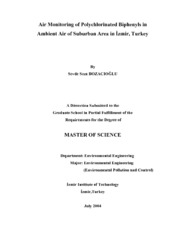Please use this identifier to cite or link to this item:
https://hdl.handle.net/11147/3343Full metadata record
| DC Field | Value | Language |
|---|---|---|
| dc.contributor.advisor | Sofuoğlu, Aysun | - |
| dc.contributor.author | Bozacıoğlu, Sevde Seza | - |
| dc.date.accessioned | 2014-07-22T13:51:21Z | - |
| dc.date.available | 2014-07-22T13:51:21Z | - |
| dc.date.issued | 2004 | - |
| dc.identifier.uri | http://hdl.handle.net/11147/3343 | - |
| dc.description | Thesis (Master)--Izmir Institute of Technology, Environmental Engineering, Izmir, 2004 | en_US |
| dc.description | Includes bibliographical references (leaves: 54-59) | en_US |
| dc.description | Text in English; Abstract: Turkish and English | en_US |
| dc.description | x, 59 leaves | en_US |
| dc.description.abstract | Polychlorinated biphenyls (PCBs) are human made toxic chemicals which were first synthesized in 1920s. Because of their inverse effects on environment and human health the usage and production of PCBs were banned in 1970s in United States and all over the Europe. PCBs are prone to long- range atmospheric transport and this makes them ubiquitous in the environment. Due to the importance of long-range transport of PCBs, their concentrations have been measured in many different countries. In order to determine the atmospheric concentration levels of total (gas+particle) PCBs (.PCB) and 41 PCB congeners in İzmir, two sampling programs were designed. 20 successive day and nighttime (called short-term), and 40 a year around representing particle and gas phase samples (called long-term) were collected from May 2003 to March 2004. Effects of temperature, wind speed and direction, and seasonal change on atmospheric concentrations of PCBs were investigated. In the short-term period, average .PCB(41) concentration was 520 pg m-3, while congener base total (gas+particle) polychlorinated biphenyl concentrations ranged from 0.37 . 0.65 pg m-3 (PCB 158) to 305.07 . 86.01 pg m-3 (PCB 33). Similarly, in the long-term analysis average .PCB(41) concentration was found as 419 pg m-3, while the minimum and maximum concentrations of congener base total (gas+particle) PCB concentrations ranged from 0.11 . 10.58 pg m-3 (PCB 70) to 919.69 . 281.18 pg m-3 (PCB 208). Short-term average total concentration was higher than a year average total concentration. The reason could be the revolatilization of these compounds from the contaminated surfaces due to the increase in temperature in early summer/late spring.Generally, the levels of PCB were within the ranges previously measured at different sites. The temperature dependence of gas-phase atmospheric concentrations of PCBs was investigated by using Clausius-Clapeyron relationship. The results were statistically significant for 12 PCB congeners (PCB 74, 70, 101, 99, 87, 82/151, 153, 138, 158, and 128). In addition to temperature, the effect of wind speed and direction was investigated using multiple linear regression analysis. Results of the multiple regression analysis indicated that wind speed was a statistically significant factor for PCB 18 and PCB 17, which have low molecular weights and tendency to be in gas phase. In the long-term data analysis with respect to Clausius-Clapeyron relationship 13 congeners (PCB 18, 17, 31, 28, 33, 74, 70, 95, 99, 153, 138, 187, and 209) were statistically significant with temperature. Introduction of wind speed and wind direction to the Clausius-Clapeyron equation did not resulted in a better correlation. The statistically significant correlated congeners were attributed as they were originated from short-range transport. The other congeners with lower R2 values and poor correlations exhibited that their sources were originated from long-range transport. The only positive slope was obtained for PCB 209 and this could be attributed to the influence of its ongoing source. Since the usage and production of PCBs were banned, the source may be the exchange processes from buildings, indoor air, soils, etc., to overlying atmosphere. | en_US |
| dc.language.iso | en | en_US |
| dc.publisher | Izmir Institute of Technology | en_US |
| dc.rights | info:eu-repo/semantics/openAccess | en_US |
| dc.subject.lcc | TD196.P65 .B79 2004 | en |
| dc.subject.lcsh | Polychlorinated biphenyls--Environmental aspects--Measurement | en |
| dc.subject.lcsh | Polychlorinated biphenyls--Environmental aspects--İzmir (Turkey) | en |
| dc.title | Air Monitoring of Polychlorinated Bibhenyls in Ambient Air of Suburban Area in Izmir, Turkey | en_US |
| dc.type | Master Thesis | en_US |
| dc.institutionauthor | Bozacıoğlu, Sevde Seza | - |
| dc.department | Thesis (Master)--İzmir Institute of Technology, Environmental Engineering | en_US |
| dc.relation.publicationcategory | Tez | en_US |
| dc.identifier.wosquality | N/A | - |
| dc.identifier.scopusquality | N/A | - |
| item.openairecristype | http://purl.org/coar/resource_type/c_18cf | - |
| item.cerifentitytype | Publications | - |
| item.fulltext | With Fulltext | - |
| item.languageiso639-1 | en | - |
| item.grantfulltext | open | - |
| item.openairetype | Master Thesis | - |
| Appears in Collections: | Master Degree / Yüksek Lisans Tezleri Sürdürülebilir Yeşil Kampüs Koleksiyonu / Sustainable Green Campus Collection | |
Files in This Item:
| File | Description | Size | Format | |
|---|---|---|---|---|
| T000440.pdf | MasterThesis | 683.02 kB | Adobe PDF |  View/Open |
CORE Recommender
Page view(s)
498
checked on Apr 28, 2025
Download(s)
158
checked on Apr 28, 2025
Google ScholarTM
Check
Items in GCRIS Repository are protected by copyright, with all rights reserved, unless otherwise indicated.